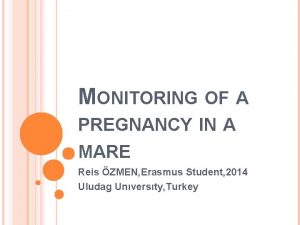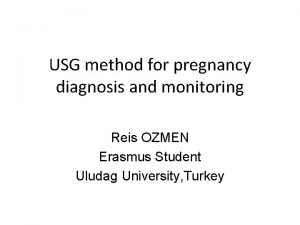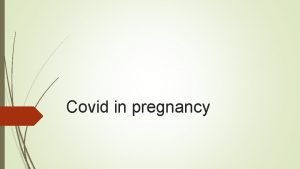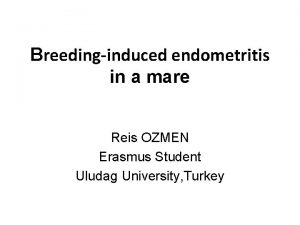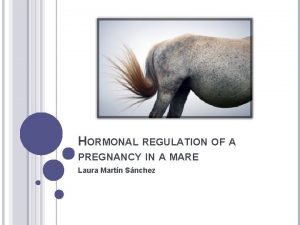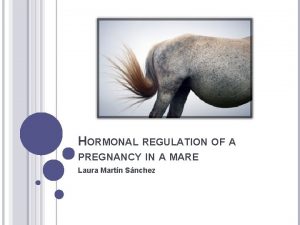MONITORING OF A PREGNANCY IN A MARE Reis




















- Slides: 20

MONITORING OF A PREGNANCY IN A MARE Reis ÖZMEN, Erasmus Student, 2014 Uludag Unıversıty, Turkey

Ø Ø Development of an equine fetus takes about 11 months from conception to birth. During this period, there are critical times when careful observation might detect a problem in time to correct a serious issue that spells harm for mare and/ foal. Normal gestation length in a mare ranges from 335 -345 days.

NON-CHEMICAL METHODS v Ø Ø Behavioural changes; The mare’s behaviour towards a stallion can be a good indicator. From about 14 days after serving, a pregnant mare should reject a stallion’s advances. That is they will not display the characteristic behaviour, which includes welcoming his advances and “showing” their rear. If a mare does not begin her oestrus cycle within 21 days of being served, it can be assumed she is pregnant.

Transrectal palpation; Ø in the rectum and feels the uterus for signs of pregnancy. These include uterine tone, the shape of the uterus, and the presence and size of the small sac containing the foetus, called the amnionic vesicle. v Ultrasound examination; Protocol (When Ovulation Time is Known) ü First exam Day 14 to 15 ü Second exam Day 24 to 27 ü Third exam Day 33 to 35 ü Autumn exam October (day of ovulation is Day 0) v

Ø Ø A rectal exam checks the tightness of the cervix, the position of the foal, the size of the uterus, and movement of the fetus. . All embryos should be detectable by day 24. By day 24 of pregnancy, the embryo is approximately 6 mm in length. The heartbeat can normally be detected as a flickering movement in the middle of the echoic embryo around this stage of pregnancy

Pregnancy diagnosis by ultrasound may initially be performed 12 to 18 days after ovulation. By day 16 of pregnancy the vesicle is normally fixed at the base of either the left or the right horn. The shape is still regular, but more ovoid than strictly spherical. By day 45, the foetus has descended approximately two-thirds of the way towards the ventral part of the allantois. The developing head of the foetus is recognisable.

Ultrasound examination on or before day 16 is also beneficial for the identification and management of Natural reduction of different size twins. twin pregnancies seen at days 14, 18 and 33 http: //www. equinereproduction. com/ articles/Twins. sht ml

CHEMICAL METHODS v ü Pregnancy testing by measuring PMSG(pregnant mare serum gonadotrophin); This is best performed between 40 and 100 days after breeding. PMSG is a protein produced by the endometrial cups – a group of cells from the embryo that temporarily colonise the lining of the mare’s uterus. Oestrone sulphate; is produced by the foetal-placental unit, and measuring its blood concentration is a well-established, reliable and accurate method for pregnancy-testing mares from 100 days post-breeding right through to the expected time of foaling

Oestrone sulphate produced by the foetal-placental unit not only finds its way into the maternal bloodstream, but also into the mare’s urine-can be used from 110 to 300 days postbreeding. urinary oestrone sulphate cont. (ug/ml) ü 50 Pregnant 40 30 20 10 0 Non-pregnant

Wee-Foal-Checker: is a non-invasive, accurate and rapid urinary test for diagnosing pregnancy in your mare. ü http: //www. weefoalchecker. co. nz /

VACCINATIONS v ü Mares are given vaccinations against diseases such as the Rhinopneumonitis (EHV-1) virus (which can cause abortions) as well as vaccines for other conditions that may occur in a given region of the world. Pre-foaling vaccines are recommended 4– 6 weeks prior to foaling to maximize the immunoglobulin content of the colostrum in the first milk. the mare should be receive; tetanus toxoid, equine influenza, and Eastern/Western encephalomyelitis (4 -way

ü Other vaccines that are recommended include equine rhinopneumonitis (EHV-1/4), Clostridium botulinum toxoid, and rabies. http: //www. fanp op. com

EXAMPLE OF VACCINATION SCHEDULE Schedule v ü ü ü Vaccine: Equine rhinopneumonitis (killed virus) Tetanus (toxoid) Equine influenza q 5, 7, and 9 mo of gestation and after foaling. q 4– 6 wkbefore due date 4– 6 wk before due date; initially administer 3 doses at 4– 6 wk intervals and then every 2– 3 mo during gestation for mares exposed to transient population q

ü Eastern and Western equine encephalomyelitis ü Rabies ü Botulism (toxoid) Usually administered to mares in late spring or early summer before onset of insect season q 4– 6 wk before due date; annual if endemic q Initially 3 doses at 1 -mo intervals, then annual booster 4– 6 wk before due date q

ü Rotaviral diarrhea ü Equine viral arteritis (modified live virus) 8, 9, and 10 mo of gestation q A negative titer should be documented by a USDA-approved laboratory before vaccination; pregnant mares should not be vaccinated; open mares should be vaccinated before breeding. q

http: //www. thehorse. com

DEWORMING v ü Deworming the mare a few weeks prior to foaling is also important, as the mare is the primary source of parasites for the foal. During the mare's pregnancy and again two to three days after foaling to minimize the transmission of parasites through the milk and in the environment. http: //myhorse. com

PARTURITION The mare should be taken to the foaling location 3– 4 weeks before the expected foaling date to enhance immunity against pathogens present in the environment. v Separation allows the mare to be monitored more closely by humans for any problems that may occur while giving birth v Mares due to foal are usually separated from other horses, both for the benefit of the mare and the safety of the soon-to-be-delivered foal. v Foaling box stalls should be large (at least 3. 5 × 3. 5 m). v

ü ü The foaling area should have good ventilation and be well bedded with clean, dry straw. The walls should be solidly constructed and free of sharp edges, The mammary gland starts developing 3– 6 weeks before foaling and distends with colostrum in most mares 2– 3 days before parturition, http: //shop. horserequisites. co. uk/HOR SECAM-FOALING-BOX-CCTV

THANKS…
 Implantation spotting
Implantation spotting Caru mare satu mare
Caru mare satu mare Picme2.0
Picme2.0 Os sete reis
Os sete reis Mariana rocha reis
Mariana rocha reis Piris reis map
Piris reis map Planejamento estratégico situacional (pes)
Planejamento estratégico situacional (pes) Charlie reis
Charlie reis Lidia vem sentar-te comigo a beira do rio
Lidia vem sentar-te comigo a beira do rio Ilha particular angra dos reis
Ilha particular angra dos reis Henry reis
Henry reis 2 reis 21
2 reis 21 D afonso ii cognome
D afonso ii cognome Carlos reis pintor
Carlos reis pintor Reis en verblijfkosten beperkt aftrekbaar
Reis en verblijfkosten beperkt aftrekbaar Nao tenhas nada nas maos
Nao tenhas nada nas maos 1 reis 17 14
1 reis 17 14 Leonhard reis
Leonhard reis Otg
Otg Fruchtstand reis
Fruchtstand reis Batman piri reis mesleki ve teknik anadolu lisesi
Batman piri reis mesleki ve teknik anadolu lisesi





















